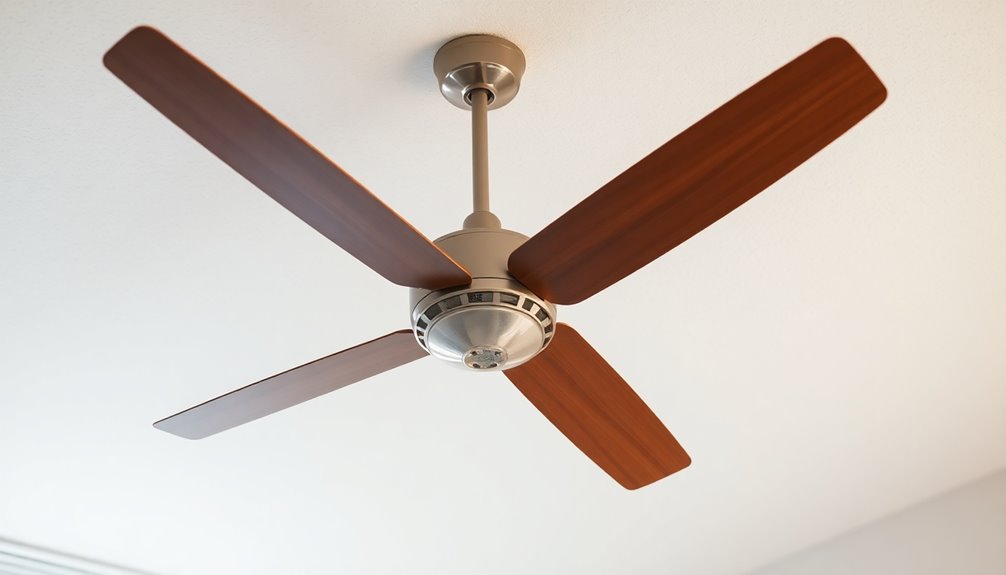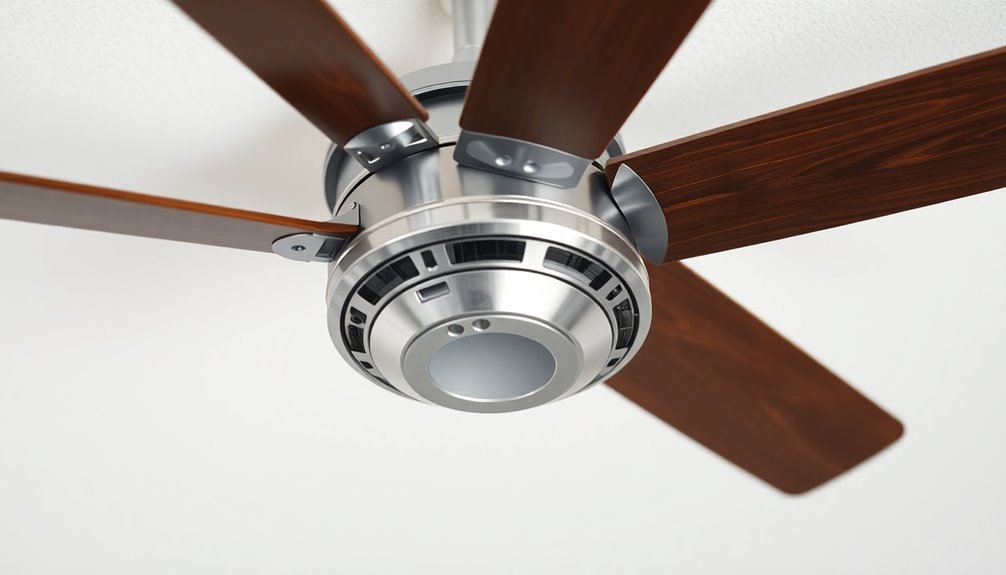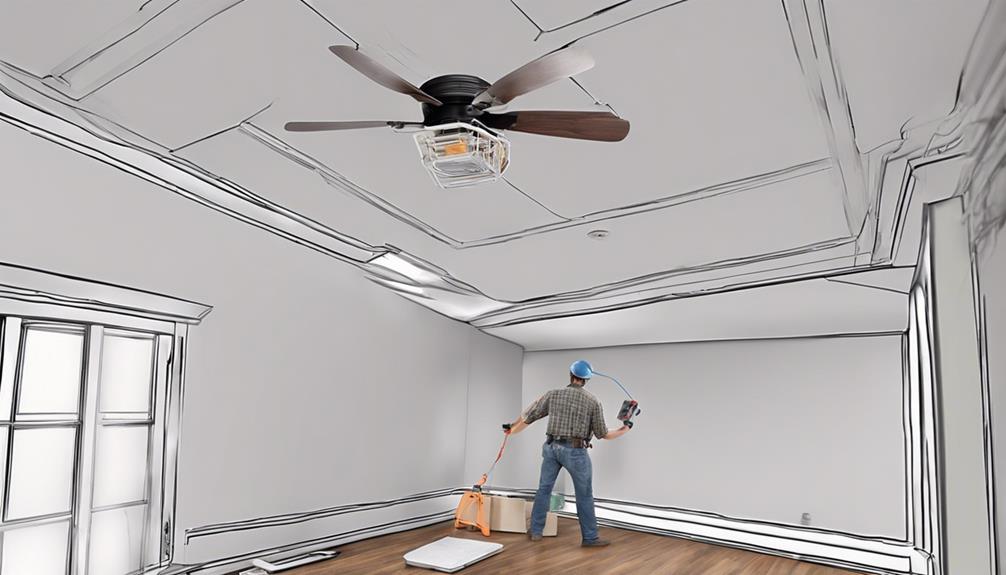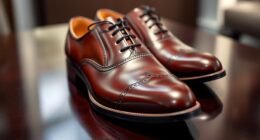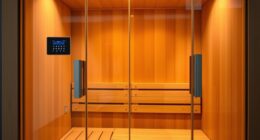Ceiling fans work by using a motor to spin blades, which generates airflow to cool your space. As the blades rotate, they push air downward, promoting sweat evaporation and making you feel cooler. You can adjust the fan's direction: counterclockwise for summer to create a breeze and clockwise for winter to circulate warm air. They're energy-efficient, using only 15-100 watts compared to traditional air conditioning units. For ideal performance, install the fan 7-9 feet above the floor. Curious about more tips on installation and efficient use? There's plenty more to discover!
Key Takeaways
- Ceiling fans operate by spinning blades that push air downwards, enhancing sweat evaporation for a cooling effect.
- The motor converts electrical energy into mechanical energy, enabling blade rotation for airflow generation.
- Fans create a low-pressure zone above, drawing in air from below for continuous circulation.
- Blade rotation direction affects airflow: counterclockwise for cooling in summer and clockwise for warmth in winter.
- Proper installation height and clearance ensure optimal airflow and performance efficiency.
Principle of Operation

Understanding how ceiling fans work begins with their principle of operation. Ceiling fans use a motor to spin the fan blades, generating air movement that creates a cooling effect. When the blades rotate, they push air downwards, enhancing evaporation of sweat from your skin, making you feel cooler without actually lowering the room temperature.
The fan blades create a low-pressure zone above them, drawing air from below. This principle relies on fluid dynamics and Bernoulli's law, which explain how air circulates effectively. By facilitating heat removal from your body, ceiling fans improve perceived comfort, especially on hot days.
You can set your ceiling fan to rotate counterclockwise during the summer for a revitalizing breeze. In winter, switch it to clockwise to circulate warm air trapped near the ceiling, helping maintain an even temperature throughout the room.
The efficiency of your ceiling fan depends on several factors, including blade design, pitch, and rotational speed. These elements work together to optimize air circulation, ensuring you enjoy the benefits of your ceiling fan all year round.
Key Components

Ceiling fans typically consist of several key components that work together to guarantee efficient operation. The motor is the heart of the fan, converting electrical energy into mechanical energy. It features a copper wire coil and rotor, which drives the fan blades.
These blades come in various sizes and shapes, often made from wood, plastic, or metal, and they notably influence the airflow and overall efficiency of the fan.
To guarantee stability, a J hook is used to attach the fan securely to the ceiling, providing the necessary support during operation. This component is essential for maintaining the fan's position and safety.
The U bolt plays a critical role by securing the motor to the J hook. It helps prevent any movement or wobbling while the fan is in use, ensuring smooth operation and longevity.
Together, these key components—the motor, fan blades, J hook, and U bolt—work in unison to create effective airflow, enhancing comfort and ventilation in your indoor spaces.
Understanding these elements can help you appreciate the design and functionality of ceiling fans.
Air Circulation Mechanism

The air circulation mechanism of a ceiling fan relies on its spinning blades to create an invigorating downward airflow that enhances comfort in any room. As the blades move, they generate a low-pressure zone above them, effectively drawing in air from surrounding areas.
This continuous air movement is essential for maximizing airflow in a room, allowing for better distribution of temperature.
Here are some key aspects of how ceiling fans achieve effective air circulation:
- Blade Design: The shape and angle of the blades directly influence airflow efficiency.
- Rotational Speed: Varying speeds allow you to customize the cooling effect based on your preferences.
- Installation Height: Blades should be positioned 7-9 feet above the floor for best performance.
- Wall Clearance: Keeping blades at least 18 inches away from walls ensures uninterrupted airflow.
Ceiling fans enhance cooling through evaporative cooling, as the increased airflow helps sweat evaporate more quickly, making you feel cooler.
Plus, by using a ceiling fan, you can enjoy better air circulation while consuming minimal energy, making it an efficient choice for comfort in your home.
Cooling Mechanism

When you turn on a ceiling fan, you activate a cooling mechanism that enhances your comfort through the evaporative cooling process.
The airflow created by the rotating blades not only helps you feel cooler but also allows you to set your thermostat higher, saving energy.
Evaporative Cooling Process
By enhancing airflow, ceiling fans considerably boost the evaporative cooling process, allowing you to feel cooler even in warmer conditions. The increased airflow accelerates sweat evaporation from your skin, providing a revitalizing sensation without actually lowering the room temperature.
You might notice that this cooling effect can make the environment feel up to 4°F cooler, helping you stay comfortable even with higher thermostat settings.
As the fan blades rotate, they create a low-pressure zone above them, drawing in air from below. This enhanced airflow promotes better heat dissipation from your body, allowing for effective cooling.
The benefits of evaporative cooling from ceiling fans are especially pronounced in low-humidity environments, where moisture evaporates more readily.
Consider these advantages of using ceiling fans for evaporative cooling:
- Energy efficiency, consuming less electricity than traditional air conditioning
- Cost-effective option for maintaining comfort
- Enhanced airflow that aids in heat dissipation
- Noticeable cooling sensation without changing the actual room temperature
Using ceiling fans not only provides comfort but also contributes to a more energy-efficient home.
Airflow and Temperature Perception
Ceiling fans enhance your comfort not just through improved airflow but also by altering your temperature perception. When you turn on a ceiling fan, its rotating blades create a downward airflow that accelerates the evaporation of moisture from your skin, producing a noticeable cooling effect. This means you can feel cooler even if the room's temperature stays the same, allowing you to raise your thermostat settings by up to 4°F without sacrificing comfort.
Utilizing Bernoulli's principle, ceiling fans create a low-pressure zone above the blades, which helps circulate warm air effectively throughout the room. In warm weather, this moving air removes excess body heat, making it an ideal solution for effective cooling.
Conversely, during winter months, reversing the fan's blade direction allows it to create an updraft, redistributing warm air that has gathered near the ceiling. This enhances your overall temperature perception, ensuring a cozy atmosphere even in colder weather.
#
Energy Efficiency Benefits
Release significant energy savings with ceiling fans, which use far less electricity than traditional air conditioning systems.
While typical AC units can consume 2,000-3,500 watts, ceiling fans operate on just 60-100 watts. This remarkable energy efficiency allows you to cool a room effectively without breaking the bank.
By increasing the evaporation rate of sweat on your skin, ceiling fans provide an invigorating breeze that enhances comfort without lowering the room temperature.
Here are some key benefits of using ceiling fans:
- You can raise your thermostat settings by up to 4°F while still feeling comfortable.
- Enjoy potential air conditioning cost reductions of 20-30%.
- Fans with reverse switches can help in circulating warm air during winter, improving heating efficiency.
- They enhance HVAC system efficiency, leading to substantial energy savings year-round.
Incorporating ceiling fans throughout your home not only keeps you cool in the summer but also guarantees you're optimizing your energy use, making them a smart choice for maintaining comfort in every season.
Installation and Maintenance

When it comes to installing your ceiling fan, proper techniques are essential for peak performance and safety.
You'll also want to establish a regular cleaning routine to keep the fan blades free of dust and guarantee smooth operation.
If you encounter issues like wobbling or noise, troubleshooting can help you get your fan back to working effectively.
Proper Installation Techniques
To guarantee your ceiling fan operates efficiently, proper installation is essential. Start by confirming the fan blades are positioned 7-9 feet above the floor and 10-12 inches below the ceiling. This placement optimizes airflow and performance.
Depending on your ceiling height, you'll need to choose between flush mount or downrod installation. Always secure the fan to a sturdy electrical box.
When connecting the wires, follow these installation techniques to confirm safety and functionality:
- Connect black to black (hot), white to white (neutral), and green or bare to ground.
- Regularly check and tighten screws and bolts after installation to prevent wobbling.
- Use the fan's reverse switch to adjust the blade direction seasonally; counterclockwise in summer for cooling and clockwise in winter for heating.
- Make sure your fan is balanced to enhance its longevity and efficiency. Additionally, consider using high CFM ratings for optimal air circulation, as this can significantly improve your ceiling fan's performance.
Regular Cleaning Practices
Maintaining a clean ceiling fan is essential for ideal performance and longevity. Regular cleaning of the blades should be done every week or two to prevent dust buildup, which can negatively affect efficiency and create noise during operation.
Use a microfiber cloth or a duster designed for ceiling fans to clean the blades effectively, guaranteeing you reach all surfaces without damaging them.
In addition to the blades, don't forget about the light fixtures attached to your fan. Wash the globes every few months to maintain brightness and prevent dust from blocking light output. This simple maintenance task helps guarantee your fan operates at its best.
You should also check and tighten screws and bolts on the fan periodically. This will guarantee stability and prevent wobbling, which can be exacerbated by dust accumulation.
Implementing a routine maintenance schedule not only extends the lifespan of your ceiling fan but also notably improves its overall efficiency and performance. By prioritizing these cleaning practices, you'll enjoy a more effective and quieter ceiling fan in your home.
Troubleshooting Common Issues
Even with regular cleaning practices in place, issues can still arise with your ceiling fan. It's important to troubleshoot these common problems for peak performance.
Start by checking the screws and bolts; loose components can lead to wobbling. A fan that produces a humming or buzzing noise is often a sign that something needs attention. Tightening and lubricating the parts can help restore smooth operation.
If you notice reduced airflow, inspect the blades for dust buildup or warping. Clean the blades regularly and consider using a balancing kit if they're misaligned. Additionally, verify that the blades turn freely without obstruction.
Lastly, if the lighting component flickers or doesn't work at all, check the wiring connections. Loose connections can lead to malfunctioning lights, and securing them can resolve the issue.
Here are some quick tips to help you troubleshoot your ceiling fan:
- Regularly tighten screws and bolts to avoid wobbling.
- Lubricate parts if you hear humming or buzzing noise.
- Clean blades to maintain efficient airflow.
- Inspect wiring connections for proper function.
With these steps, your ceiling fan should operate smoothly and effectively.
## Energy Efficiency Benefits

Ceiling fans deliver impressive energy efficiency benefits that can greatly reduce your utility bills. Unlike air conditioning units that consume 2,000-4,000 watts, a ceiling fan typically uses only 15-100 watts. This significant difference leads to substantial energy savings.
By creating a revitalizing breeze, you can comfortably raise your thermostat settings by about 4°F, which means you'll rely less on your air conditioning system.
When you use ceiling fans in occupied rooms, you enhance HVAC efficiency, potentially lowering your energy bills by 30% when paired with proper temperature settings. Investing in Energy Star certified ceiling fans can further boost energy efficiency, as these models are up to 40% more efficient than conventional ones.
Regular use of ceiling fans not only helps to keep your home comfortable but also extends the lifespan of your heating and cooling systems. By reducing their workload, you contribute to long-term energy savings and lower maintenance costs.
Frequently Asked Questions
Which Way Should a Ceiling Fan Turn in the Summer?
In the summer, your ceiling fan should turn counterclockwise. This direction creates a downdraft, pushing cool air down towards you and enhancing your comfort.
You'll want to set it on medium or high to maximize airflow, helping to evaporate sweat and keep you feeling cooler.
How Do Ceiling Fans Cool a Room?
Imagine stepping into a warm room, the sun baking the walls, and you just want to cool down.
Ceiling fans create a revitalizing breeze that enhances evaporation on your skin, making you feel cooler without lowering the temperature. As the blades spin, they draw in air, circulating it throughout the space.
How Does a Ceiling Fan Work Step by Step?
To understand how a ceiling fan works step by step, you first turn it on, activating the electric motor.
This motor spins the blades, which are angled to create airflow. As the blades rotate counterclockwise, they push air downwards, creating a cooling breeze that enhances evaporation on your skin.
If you switch it to clockwise, it circulates warm air, redistributing heat for comfort in colder months.
You're maximizing airflow and temperature control effortlessly!
Should You Leave Ceiling Fans on All the Time?
You shouldn't leave ceiling fans on all the time, as they cool people through airflow rather than lowering the room temperature.
When you're not in the room, there's no need for the fan to run, leading to unnecessary energy consumption.
Instead, use ceiling fans when you're present and consider turning them off when you leave.
This way, you can maximize comfort and efficiency while reducing your energy bills considerably over time.
Conclusion
Now that you know how ceiling fans work, you can appreciate their role in keeping your space comfortable. By circulating air and enhancing your cooling system, these fans can make summer feel like a revitalizing breeze off the ocean. Plus, with easy installation and minimal maintenance, they're a breeze to manage! So, next time you flip the switch, remember: you're not just turning on a fan; you're releasing a whirlwind of comfort in your home!


